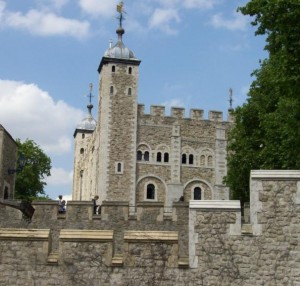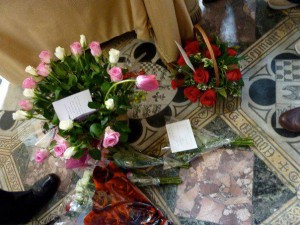 The Tower of London, or Her Majesty’s Royal Palace and Fortress as it is officially called, is famous for being the site of much bloodshed and for being the prison of many hundreds, if not thousands, of people since it was first built by William the Conqueror in the late 11th century, but it has had many different roles during its 900 year history:-
The Tower of London, or Her Majesty’s Royal Palace and Fortress as it is officially called, is famous for being the site of much bloodshed and for being the prison of many hundreds, if not thousands, of people since it was first built by William the Conqueror in the late 11th century, but it has had many different roles during its 900 year history:-
- Fortess
- Prison
- Royal Palace
- Armoury
- Mint
- Place of Execution
- Home of the Royal Menagerie
- Jewel house
- Resting Place
In Tudor times, the Tower of London was used as a prison. Notable prisoners included:-
- Anne Boleyn and the five men condemned to death for committing adultery with her
- Sir Thomas More and Bishop John Fisher
- Thomas Cromwell
- Catherine Howard and Lady Jane Rochford
- Anne Askew
- Thomas Cranmer
- Lady Jane Grey and Guildford Dudley
- Princess Elizabeth Tudor and Robert Dudley during Mary I’s reign
- Sir Walter Ralegh
However, it was not just a prison, it was also a Royal Palace complete with Great Hall and royal lodgings which were used by a monarch traditionally before his/her coronation. Although that royal palace no longer stands, we know that it stood on the area between the Wardrobe and Lanthorn Towers.
The Tower of London and Anne Boleyn
Although the Tower of London is most commonly associated with Anne’s imprisonment and execution, it also played a big part in her coronation in 1533. Henry VIII ordered the Queen’s Lodgings in the royal palace to be renovated and spent the equivalent of over £1 million pounds making them suitable for his new wife and queen. Luxury lodgings complete with a gallery and private gardens! It was in those lodgings that Anne spent the night before her coronation and, ironically, she was also imprisoned in them in May 1536.
Yeoman Warders often point out the half-timbered Queen’s House as the place where Anne Boleyn was imprisoned in the lead-up to her execution, but this just isn’t true. This building overlooking Tower Green was not built until 1540, four years after Anne’s death. If that doesn’t confuse Tower visitors enough, the glass scaffold memorial on Tower Green does not mark the spot on which Anne Boleyn was executed. We know from primary sources, which describe Anne’s final walk, that Anne’s scaffold was actually located on the present day parade ground between the White Tower and the Waterloo Barracks, where the Crown Jewels are house. When you visit the Tower of London, stand between the White Tower and the entrance to the Crown Jewels and pay your respects there, that’s where it happened!
Another fallacy is that Anne Boleyn entered the Tower of London by Traitors Gate. She didn’t. Anne was taken to the private entrance of the Court Gate in the Byward Tower, she was Queen after all!
After her execution on the 19th May 1536, Anne Boleyn’s head and body were taken away by her ladies, wrapped in a white cloth and placed in an elm arrow chest for burial. She was then buried in the Chapel of St Peter ad Vincula, which lies in the Tower grounds. When work was carried out on the Chapel in 1876, the Victorians found female remains in the area recorded as being the resting place of Anne Boleyn and after examining the remains she was reinterred in the Chancel area in a box marked “Queen Anne Boleyn”. Her resting place, and those of others including Catherine Howard, Lady Jane Rochford, Lady Jane Grey and Margaret Pole, were then marked by a memorial tile on the beautifully tiled floor. Today, visitors can pay their respects at the Chapel and on the anniversary of Anne’s execution a basket of red roses is delivered to the Tower to be placed on her tile.

The Tower of London is visited on every single one of our tours because of its link with Anne Boleyn, Catherine Howard, Lady Jane Grey and Tudor times in general. It is an incredible building and highlights include:-
- The Medieval Palace – Built by Henry III and Edward I in the 13th century
- Traitors Gate – The notorious Tower entrance
- The Wall Walk – See the Tower, Tower Bridge and the River Thames
- Tower Green and the scaffold memorial – It may not be the site of Anne Boleyn’s execution but the glass memorial is still an appropriate place to pause a while
- The Chapel of St Peter ad Vincula – Not just the resting place of prominent Tudor people, including Anne Boleyn, but also a tranquil place of worship
- The Beauchamp Tower with its Tudor prisoners’ graffiti (carvings into the stone)
- The Bloody Tower – Traditionally thought to be the place where the Princes in the Tower were murdered, and the location of Sir Walter Ralegh’s room.
- The Crown Jewels
- The White Tower – See the beautiful St John’s Chapel and various displays and exhibitions, including Henry VIII’s armour
- The Ravens – Legend has it that the kingdom and Tower will fall if the ravens ever leave the Tower, so seven ravens are kept at the Tower. Visitors can see their lodgings by the Wakefield Tower
I hope that has given you a taster of the Tower of London. Click here to check out our tours which all visit this iconic building and remember our special Early Bird Booking which allows you to save £100 on the Executed Queens and Discover the Tudors tours if you book before midnight on Monday 22nd.
[slideshow id=426 w=400 h=300]
Have you been to the Tower? Which was your favourite bit?